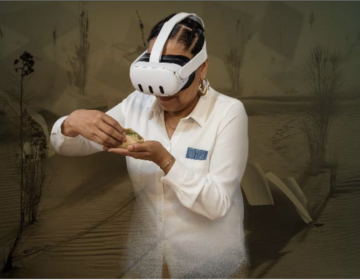A president and his property
The home where George Washington shared space with his slaves has opened to visitors. The long-buried structure also opened a debate about race in America’s history.
Get a first glance of the President’s House before the ribbon cutting ceremony. (Lindsay Lazarski/Newsworks)
It’s been a long time coming. On Wednesday, the historic President’s House will officially open on Independence Mall. The plan to develop a small museum on the site where the presidential home and offices of George Washington once stood has been brewing for at least eight years. It also became one of the most contentious historical spats in the region.
It started in 2002 when historian Gary Nash quipped on WHYY’s Radio Times that in order to access the Liberty Bell Pavilion on Independence Mall, a visitor would have to literally step over the site where George Washington once housed his slaves.
From there, questions of what to do with the site expanded: Should this be about the birth of our nation? Should this be about slavery?
Intense public meetings were held, pitting African-American activists with academic historians and National Park Service officials. Historian Randall Miller, who was part of the process early on, said the public was included in an unprecedented way.
“Different constituencies talked, discovered and developed through this process,” said Miller, a member of the Ad Hoc Historian Association. “There was constant public interest — not complete, but they demanded greater responsibility to respect public interest.”
More coverage:
Allen’s Lane Blog: Mass’ah Washington’s House
President’s House reconciles glorification with reality
NPR coverage of the opening
The result is an open plan of partial walls suggesting the layout of the President’s House, adorned with permanent video displays about the stories of Washington’s slaves in the same space the framework of American Democracy was being hammered out.
Seth Bruggeman of Temple University said the long fight to get to this point should not have been necessary.
“If you really want to see an impressive model of community conversation and public outreach around the subject of slavery — go to historic Cliveden in the Germantown section of Philadelphia,” said Bruggeman, the director of Temple’s Center for Public History. “Those folks are doing remarkable work — and you don’t hear about it because the President’s House has really stolen the wind from that sail.”
Bruggeman hopes the meaning attributed to the President’s House will not be limited just to race, but include other factors influencing the birth of the nation — like political parties and international pressure.
WHYY is your source for fact-based, in-depth journalism and information. As a nonprofit organization, we rely on financial support from readers like you. Please give today.




